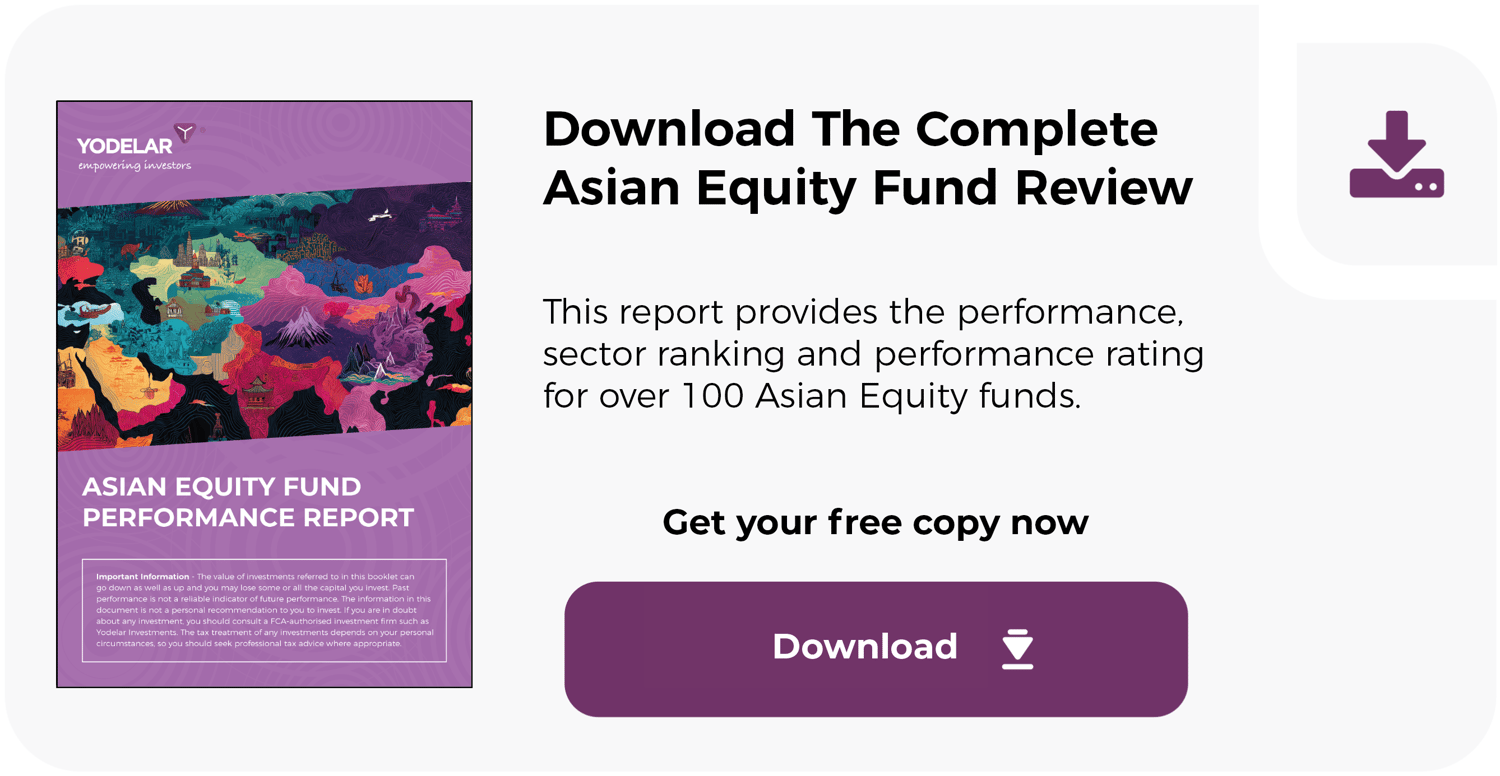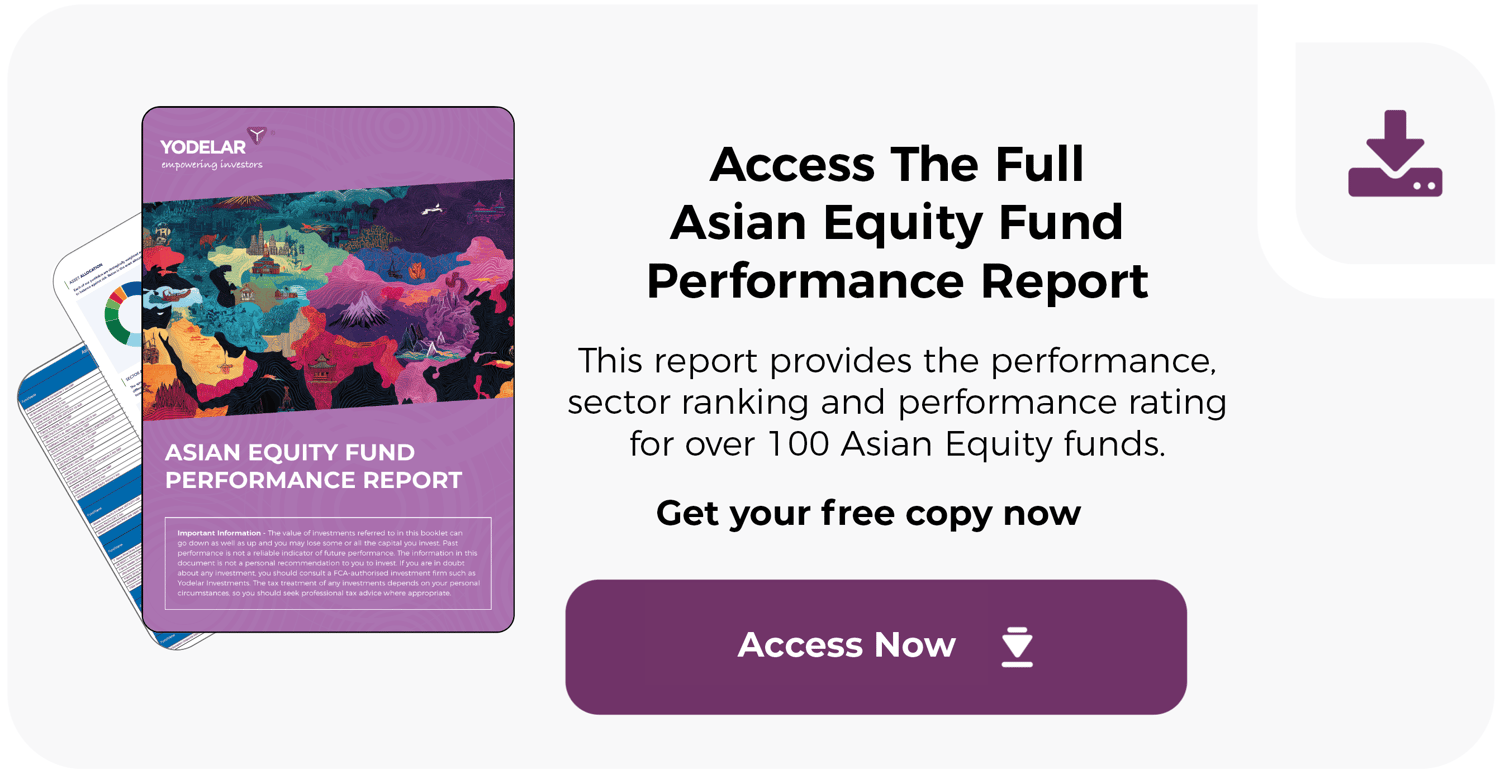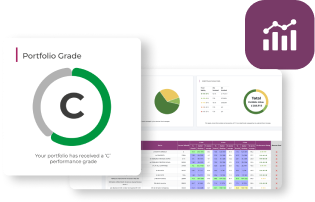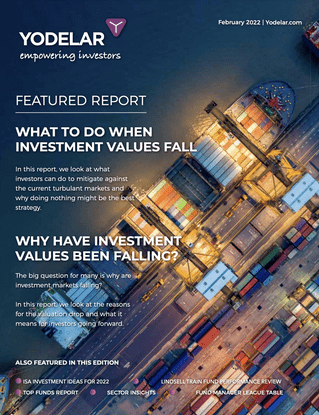-
Asian equity markets have rebounded strongly in 2025, supported by increased foreign investment and renewed strength in technology, consumer goods, and financial sectors.
-
Of the 107 Asian equity funds analysed, only 20 achieved a top 4 or 5-star rating for consistently outperforming their sector across multiple timeframes.
-
65 funds (approximately 61%) underperformed their sector averages, highlighting the significant disparity in fund quality and the importance of careful selection.
-
The 10 highlighted funds delivered strong results over 6-month, 1-year, 3-year, and 5-year periods, with many outperforming by a wide margin due to sector tilts, active stock selection, or enhanced index strategies.
Asian equity markets have endured a turbulent few years, grappling with the economic fallout from the pandemic, persistent trade tensions, and a prolonged slowdown in China. But by the end of 2023, sentiment began to shift. Strengthening demand across key sectors such as technology, financial services, and consumer goods has helped restore confidence, with foreign capital returning in meaningful volumes by early 2025.
This resurgence has re-established Asia’s relevance as a high-growth investment region. While risks remain, the potential rewards have attracted renewed attention from investors seeking long-term capital appreciation. For those with an appetite for volatility, Asian equities are once again seen as a powerful diversification tool within a global portfolio.
In this article, we analyse the performance of more than 100 Asian equity funds and identify 10 that have consistently delivered superior returns over the past 6 months, 1 year, 3 years, and 5 years. We also examine the broader trends driving growth across Asian markets and explain why many believe this region is poised for a strong decade ahead.
Asian Equity Funds Performance Summary
Asian equity markets span a broad mix of developed and emerging economies, offering investors exposure to diverse growth drivers. But with this diversity comes variability - both in strategy and in performance.
Our latest analysis reviewed 107 equity funds within the IA Asia Pacific ex Japan sector, assessing their returns and sector rankings over the past 6-month, 1-year, 3-year, and 5-year periods. Each fund was rated according to how consistently it outperformed its sector peers across these timeframes.
Of the funds reviewed, only 20 earned a top 4 or 5-star rating for consistent outperformance across multiple timeframes. In contrast, 65 funds - representing 61% of the sector - were rated 1 or 2 stars, reflecting a pattern of underperformance relative to peers.

These findings highlight a significant performance gap between the best and worst funds in the sector. With such wide variation, careful fund selection remains essential for investors looking to benefit from Asia’s long-term growth potential while managing risk effectively.
10 Top Performing Asian Equity Funds
The 10 funds featured below have demonstrated consistent outperformance across multiple timeframes. Each has ranked among the leading performers within the IA Asia Pacific ex Japan sector over the periods analysed. The table highlights their performance over the past 6-month, 1-year, 3-year, and 5-year periods.

The below chart provides the annual performance of each fund over each of the past 5 full years.

Each of these funds has earned a top 4 or 5-star rating, reflecting their performance relative to sector peers.
1. abrdn Asia Pacific Equity Enhanced Index
Launched in March 2016, the abrdn Asia Pacific Equity Enhanced Index B Acc fund invests primarily in Asia Pacific companies, excluding Japan, with at least 70% of its holdings aligned to the MSCI AC Asia Pacific ex Japan Index. While it broadly tracks the index, it applies a rules-based approach that tilts towards companies with favourable characteristics such as strong balance sheets or recent share price momentum.
The fund has £317.9 million in assets and has delivered results above the sector average across all measured timeframes. Over six months, it returned 3.96%, ranking 26th out of 107 funds. Its one-year return of 8.29% also outperformed the sector average of 4.89%. Over three and five years, it returned 17.97% and 35.49% respectively, compared to sector averages of 10.26% and 25.49%.
Recent performance has been supported by exposure to large-cap companies including Taiwan Semiconductor, Tencent, Samsung Electronics, and HDFC Bank. With an ongoing charge of 0.19%, it ranks among the lower-cost options in the sector.
This fund’s performance reflects a disciplined investment process and a regional bias towards technology and financials, which have been key drivers of returns in the current market cycle.
2. BNY Mellon Asian Income Fund
The BNY Mellon Asian Income fund aims to provide both income and long-term capital growth by investing in dividend-paying companies across the Asia Pacific region, excluding Japan. At least 75% of the portfolio is allocated to firms either based in or doing substantial business within the region, including Australia and New Zealand.
The fund manages £711.47 million in assets and has delivered returns above the sector average across multiple timeframes. Over six months, it returned 3.60%, placing it in the top half of its sector. Its one-year return of 8.05% compared favourably to the sector average of 4.89%, while its three-year and five-year returns of 20.08% and 45.08% ranked 16th and 7th respectively out of 105 and 96 funds.
Its portfolio has been weighted towards markets such as Taiwan, Singapore, and Australia, with key holdings including Taiwan Semiconductor, DBS Group, Samsung Electronics, and Singapore Technologies. These companies have contributed to overall returns through stable earnings and dividend payments.
The fund’s results reflect a focus on income-generating stocks combined with broad regional exposure. While performance has been strong, future returns remain subject to dividend trends and regional economic conditions.
3. Federated Hermes Asia ex-Japan Equity Fund
The Federated Hermes Asia ex-Japan Equity fund invests in companies across the Asian region that generate the majority of their revenue locally, with a focus on long-term capital growth. The fund manages £3.36 billion in assets and excludes Japanese markets from its remit.
It has delivered strong results across all measured timeframes. Over six months, it returned 6.16%, ranking 9th out of 107 funds. Its one-year return of 12.02% was significantly ahead of the sector average of 4.89%. Over three years, it delivered 24.20%, while its five-year return of 55.49% ranked 5th out of 96 funds - more than double the sector average of 25.49%.
The fund applies a value-based approach, targeting companies that appear undervalued but maintain sound financial fundamentals. It also incorporates environmental, social, and governance (ESG) criteria as part of its stock selection process. Its holdings have typically been concentrated in sectors such as technology, financials, and consumer-focused businesses - areas that have benefited from demographic and economic changes across the region.
While returns have been strong, the strategy is more focused on emerging and less widely held companies, which may lead to higher volatility over time.
4. Guinness Asian Equity Income Fund
The Guinness Asian Equity Income fund invests in dividend-paying companies across the Asia Pacific region, excluding Japan, with the aim of delivering a combination of income and long-term capital growth. The fund holds a concentrated portfolio of 36 stocks and manages £250 million in assets.
It has delivered consistently strong performance across all key timeframes. Over six months, the fund returned 4.82%, ranking 12th out of 107 funds. Its one-year return of 14.66% was the second highest in the sector, well above the average of 4.89%. Over three years, it returned 23.75%, and over five years, 53.66%, ranking 8th out of 96 funds and more than doubling the sector average over that period.
Performance has been supported by investments in financial and industrial companies, including China Merchants Bank, Elite Material, and Industrial and Commercial Bank of China. The fund’s focus on companies with stable earnings, strong financials, and the ability to grow dividends has contributed to its results during varied market conditions.
The fund's concentrated approach means performance can be more sensitive to individual stock movements, but recent returns indicate its portfolio positioning has been well aligned with market trends in the region.
5. HSBC Pacific Index Fund
The HSBC Pacific Index fund is a passive strategy that aims to match the performance of the FTSE World Asia Pacific ex Japan Index, offering exposure to a broad range of companies across the region. It manages approximately £683 million in assets and is designed for long-term capital growth.
Over the past six months, the fund returned 3.66%, ahead of the sector average of 2.18%. Its one-year return of 5.02% placed it in the upper half of its peer group. Over longer periods, it has remained competitive, with a three-year return of 23.11% and a five-year return of 49.98%, ranking it in the top quartile of its sector.
The fund’s portfolio spans key markets including China, Australia, and South Korea, and its performance reflects the overall strength of these regions over the review period. As an index tracker, it does not actively select individual stocks but instead aims to replicate the returns of its benchmark.
With an ongoing charge of 0.17%, the fund is one of the lower-cost options in the sector. Its results highlight how a broad, diversified approach to the Asia Pacific region has delivered competitive returns in recent years.
6. Invesco Asian Fund
The Invesco Asian (UK) Z Acc fund invests primarily in companies across Asia and Australasia, excluding Japan, with at least 80% of its portfolio allocated to the region. The fund takes an active approach, focusing on companies it identifies as undervalued but with strong long-term growth potential.
It currently manages £2.48 billion in assets and has produced competitive results across all key timeframes. Over six months, it returned 2.99%, slightly ahead of the sector average of 2.18%. Its one-year return of 7.72% placed it in the top half of its peer group. Over three and five years, the fund delivered 19.58% and 54.15% respectively, ranking 17th and 7th within its sector.
Recent performance has been supported by exposure to technology and industrial companies in China and Taiwan, as well as gains from communication services and selected cyclical sectors. Broader macroeconomic factors — including currency movements and increased foreign investment in markets such as India and South Korea — also contributed to returns.
Unlike index-tracking funds, this portfolio is not restricted by a benchmark, which gives it greater flexibility to adjust to market conditions. However, this also means performance can diverge significantly from the broader market, depending on individual stock and sector decisions.
7. iShares Pacific ex Japan Equity Index
The iShares Pacific ex Japan Equity Index (UK) D fund tracks the performance of the FTSE World Asia-Pacific ex Japan Index, providing exposure to a broad mix of companies across the region. It uses a passive strategy, investing directly in the same companies as the benchmark, which includes major markets such as Australia, South Korea, Taiwan, and Hong Kong.
Over the past six months, the fund returned 4.51%, outperforming the sector average of 2.18%. Its one-year return of 5.14% placed it mid-range among 107 funds. Longer-term performance has been strong, with a three-year return of 24% and a five-year return of 51.70%, ranking 8th and 11th in the sector respectively.
Performance has been supported by holdings in large regional companies such as Taiwan Semiconductor and Samsung Electronics, which have benefited from demand in the technology sector. The fund currently manages over £1.77 billion and applies a low-cost model, with an annual fee of 0.11%, making it one of the more cost-efficient options in the market.
As with other index-tracking funds, outcomes are closely tied to the performance of the underlying benchmark. Its recent results reflect both the strength of key regional markets and the advantages of broad, low-cost exposure.
8. Jupiter Merian Asia Pacific Fund
The Jupiter Merian Asia Pacific I Acc fund invests in companies across Asia and Australasia, excluding Japan, with the objective of delivering long-term capital growth. At least 70% of its assets are allocated to the region, with scope to invest in selected emerging markets where appropriate.
The fund adopts an active investment approach, assessing company fundamentals such as valuation, balance sheet strength, growth potential, and prevailing market conditions. It also uses derivatives in limited cases to manage risk or reduce costs.
With £327.54 million in assets under management, the fund has delivered strong results over all key timeframes. Over six months, it returned 3.68%, above the sector average of 2.18%. Its one-year return of 11.09% was more than double the sector average of 4.89%. Over three years, it returned 30.96%, ranking 2nd out of 105 funds, and over five years, it returned 57.27%, ranking 4th out of 96 funds.
Performance has been supported by exposure to sectors such as technology and financials, which have benefited from increased demand and supportive regional policy conditions. The fund's active positioning has contributed to its returns, though its focused approach means performance may be more sensitive to sector-specific risks.
9. M&G Asian Fund
The M&G Asian I Acc GBP fund invests across the Asia Pacific region (excluding Japan) with a focus on both capital growth and income. The fund targets companies that appear undervalued but have strong future earnings potential and sound corporate governance.
It manages £656.46 million in assets and has delivered strong performance across all timeframes. Over six months, it returned 3.94%, ranking 27th out of 107 funds. Its one-year return of 11.99% was well above the sector average of 4.89%. Over three years, the fund delivered 31.23%, the highest in its peer group of 105 funds. Over five years, it returned 66.47%, ranking 2nd out of 96 funds.
Returns have been supported by exposure to sectors such as consumer discretionary and financials, with holdings including Atour Lifestyle, Samsung Life, and AIA Group contributing positively. The fund’s active approach and flexible allocation have allowed it to adjust positioning in response to changing market conditions.
While recent results have been strong, the fund’s strategy remains dependent on its ability to identify undervalued opportunities and manage sector-level risks effectively.
10. Schroder Asian Income Fund
The Schroder Asian Income Z Acc fund invests primarily in dividend-paying companies across the Asia Pacific region, excluding Japan. At least 80% of the portfolio is allocated to the region, with exposure to markets such as Australia, New Zealand, and key parts of Southeast Asia. The fund aims to deliver both income and long-term capital growth over a three to five-year period.
It currently manages £1.21 billion and has delivered consistent results across a range of market conditions. Over six months, it returned 4%, outperforming the sector average of 2.18%. Its one-year return of 5.87% also exceeded the sector average of 4.89%. Over three years, it returned 21.09%, and over five years, 52.84%, ranking 10th out of 96 funds.
Recent performance has been supported by holdings in companies such as Taiwan Semiconductor, SingTel, OCBC, and BOC Hong Kong, with contributions from sectors including Financials, Technology, and Telecommunications. These areas have seen stronger earnings recovery in recent years.
The fund’s focus on quality income-generating stocks has helped it remain competitive within the IA Asia Pacific ex Japan sector, though its income bias may influence performance during periods where growth-led strategies dominate.
Summary
Asian equity markets have staged a strong recovery in 2025, particularly during the second quarter, supported by renewed foreign investment and growth in key sectors such as technology, consumer goods, and financials. This turnaround follows several years of muted performance, during which sentiment was held back by global headwinds and China’s prolonged slowdown. As conditions have improved, Asia has re-emerged as a high-growth region and a valuable consideration for long-term investors.
Our analysis of 107 IA Asia Pacific ex Japan funds found that only 20 achieved a top 4 or 5-star rating based on consistent outperformance across the 6-month, 1-year, 3-year, and 5-year periods. In contrast, 61% of funds underperformed their sector average – highlighting the wide variation in fund quality and the importance of careful fund selection. The 10 funds featured in this article each ranked among the strongest in the sector, driven by diverse strategies including enhanced index approaches, high-conviction active management, and income-focused mandates.
While no fund can guarantee future success, the results underline how different strategies respond to shifting market conditions – and why a well-diversified, forward-looking portfolio remains essential to navigating global investment opportunities effectively.
Building a Portfolio That’s Structured for the Future
Asian equities can play an important role within a well-diversified investment portfolio, offering exposure to dynamic economies and high-growth industries. But as with all asset classes, their performance can vary significantly depending on broader market conditions.
Fund performance can differ greatly across regions, sectors, and industries – and what excels in one cycle may lag in the next. This variability reinforces the fact that long-term investment success isn’t about chasing past performance. While historical returns provide valuable perspective, they’re not a guide to future outcomes.
What matters more is how a portfolio is structured and managed over time. Strong diversification, an efficient asset model, and a clearly defined investment strategy are essential to delivering consistent, long-term results. This includes maintaining balance across geographies and asset types, and making forward-looking decisions based on ongoing research – not hindsight.
Following Yodelar’s merger with MKC Wealth, our clients can benefit from portfolios managed on a discretionary basis by MKC Invest – a discretionary fund management firm within the MKC group. This structure enables timely portfolio adjustments without delay, helping to keep investments aligned with changing markets and evolving client objectives.
Efficient portfolio management requires more than an annual review. It demands regular oversight, evidence-based fund selection, and the ability to adapt with precision. If you’re unsure whether your current portfolio is positioned for long-term success, a professional review can provide the clarity you need. Book a call with our team today to explore whether there are better-aligned solutions for your investment goals.



















